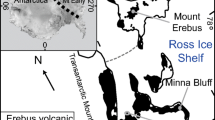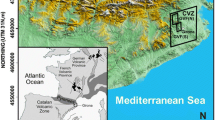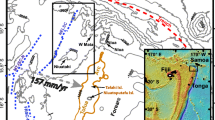Abstract
Pyroclastic deposits exposed in the caldera walls of Santorini Volcano (Greece), contain several prominent horizons of coarse-grained andesitic spatter and cauliform volcanic bombs. These deposits can be traced around most of the caldera wall. They thicken in depressions and are intimately associated with ignimbrite and co-ignimbrite lithic lag breccias. They are interpreted as a proximal facies of pyroclastic flow deposits. Evidence for a flow origin includes the presence of a fine-grained pumiceous matrix, flow deformation of ductile spatter clasts, exceedingly coarse grain sizes several kilometres from any plausible vent, imbrication of flattened spatter clasts, intimate interbedding with normal pyroclastic flow deposits and the presence of inversely graded basal layers. The deposits contain hydrothermally altered, rounded lithic ejecta including gabbro nodules. The andesitic ejecta and the fine matrix are typically moderately to poorly vesicular indicating that magmatic gas had a subordinate role in the eruptive process. The andesitic clasts contain abundant angular lithic inclusions and some clasts are themselves formed of pre-existing agglutinate. We propose that these eruptions occurred when external water gained access to the vents, causing large-scale explosions which formed pyroclastic flows rich in coarse, semifluid but poorly vesicular ejecta. We postulate that large volumes of coarse pyroclastic ejecta and degassed lava accumulated in a deep crater prior to being disrupted by these large explosions to form pyroclastic flows.
Similar content being viewed by others
References
Barton M, Huijsmans JPP (1986) Post-caldera dacites from the Santorini volcanic complex, Aegean Sea, Greece; an example of the eruption of lavas of near-constant composition over a 2200 year period. Contrib Mineral Petrol 94:472–495
Bond A, Sparks RSJ (1976) The Minoan eruption of Santorini, Greece. J Geol Soc London 132:1–16
Druitt TH (1985) Vent evolution and lag breccia formation during the Cape Riva eruption of Santorini, Greece. J Geol 93:439–454
Druitt TH, Sparks RSJ (1982) A proximal ignimbrite facies on Santorini, Greece. J Volcanol Geotherm Res 13:147–171
Druitt TH, Sparks RSJ (1984) On the formation of calderas during ignimbrite eruptions. Nature 310:679–681
Druitt TH, Mellors RA, Pyle DM, Sparks RSJ (1989) Explosive volcanism on Santorini, Greece. Geol Mag 126:95–126
Fisher RV, Schmincke H-U (1984) Pyroclastic Rocks. Springer-Verlag, Berlin. 472 pp
Friedrich WL (1987) Statigrafi i et Vulkansk omrade-Santorini someksempel. Dansk geologisk Forening 1–6
Friedrich WL, Pichler H, Kussmaul S (1977) Quaternary pyroclastics from Santorini, Greece and their significance for the Mediterranean palaeoclimate. Bull Geol Soc Denmark 26:27–39
Heiken G, McCoy FW Jr (1984) Caldera development during the Minoan eruption, Thira, Cyclades, Greece. J Geophys Res 89:8441–8462
Houghton BF, Wilson CJN (1989) A vesicularity index for pyroclastic deposits. Bulletin Volcanol 51:451–462
Huijsmans JPP (1985) Calc-alkaline lavas from the volcanic complex of Santorini, Aegean Sea, Greece. Geol. Ultraiectina 41:1–316
Mann AC (1983) The trace element geochemistry of the high-alumina basalt-andesite-rhyodacite lavas of the Main Series of Santorini Volcano, Greece. Contrib Mineral Petrol 84:43–57
Nairn IA (1979) Rotomahana-Waimangu eruption 1886; base surge and basalt magma. NZ J Geol Geophys 22:363–378
Nicholls IA (1971) Petrology of Santorini Volcano, Cyclades, Greece. J Petrol 12:67–119
Pichler H, Kussmaul S (1972) The calc-alkaline rocks of the Santorini Group (Aegean Sea, Greece). Neues Jahrb Abh 116:268–307
Pichler H, Kussmaul S (1980) Comments on the geological map of the Santorini Islands. In: Doumas C (ed) Thera and the Aegean World II, Thera and the Aegean World, London, pp 413–427
Pyle DM, Ivanovich M, Sparks RSJ (1988) Magma-cumulate mixing identified by U-Th disequilibrium dating. Nature 331:157–159
Sparks RSJ, Self S, Walker GPL (1973) The products of ignimbrite eruptions. Geology 1:115–118
Sparks RSJ, Wright JV (1979) Welded airfall tuffs. In: Chapin CE, Elston WE (eds) Ash flow tuffs. Geol Soc Am Spec Paper 180:155–160
Trigila R, Walker GPL (1986) The Onano spatter flow, Italy:evidence for a new ignimbrite depositional mechanism. Abstracts of the International Volcanological Congress, New Zealand, 1986
Walker GPL (1971) Grain-size characteristics of pyroclastic deposits. J Geol 79:696–714
Walker GPL (1985) Origin of coarse lithic breccias near ignimbrite source vents. J Volcanol Geotherm Res 25:157–171
Walker GPL, Self S, Wilson L (1984) Tarawera 1886, New Zealand — a basaltic plinian fissure eruption. J Volcanol Geotherm Res 21:61–78
Walson L (1972) Explosive volcanic eruptions — II. The atmospheric trajectories of pyroclasts. Geophys J R Astr Soc 45:543–556
Wright JV, Walker GPL (1977) The ignimbrite source problem: significance of a co-ignimbrite lag-fall deposit. Geology 5:729–732
Author information
Authors and Affiliations
Rights and permissions
About this article
Cite this article
Mellors, R., Sparks, R. Spatter-rich pyroclastic flow deposits on Santorini, Greece. Bull Volcanol 53, 327–342 (1991). https://doi.org/10.1007/BF00280225
Received:
Accepted:
Issue Date:
DOI: https://doi.org/10.1007/BF00280225




